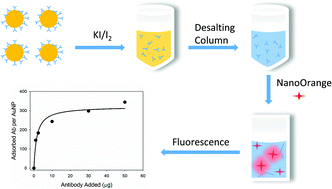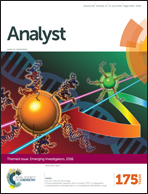A fluorescence-based method to directly quantify antibodies immobilized on gold nanoparticles†
Abstract
The ability to evaluate antibody immobilization onto gold nanoparticles is critical for assessing coupling chemistry and optimizing the sensitivity of nanoparticle-enabled biosensors. Herein, we developed a fluorescence-based method for directly quantifying antibodies bound onto gold nanoparticles. Antibody-modified gold nanoparticles were treated with KI/I2 etchant to dissolve the gold nanoparticles. A desalting spin column was used to recover the antibody released from the nanoparticles, and NanoOrange, a fluorescent dye, was used to quantify the antibody. We determined 309 ± 93 antibodies adsorb onto a 60 nm gold nanoparticles (2.6 × 1010 NP mL−1), which is consistent with a fully adsorbed monolayer based on the footprint of an IgG molecule. Moreover, the increase in hydrodynamic diameter of the conjugated nanoparticle (76 nm) compared to that of the unconjugated nanoparticle (62 nm) confirmed that multilayers did not form. A more conventional method of indirectly quantifying the adsorbed antibody by analysis of the supernatant overestimated the antibody surface coverage (660 ± 87 antibodies per nanoparticle); thus we propose the method described herein as a more accurate alternative to the conventional approach.

- This article is part of the themed collection: Emerging Investigators

 Please wait while we load your content...
Please wait while we load your content...